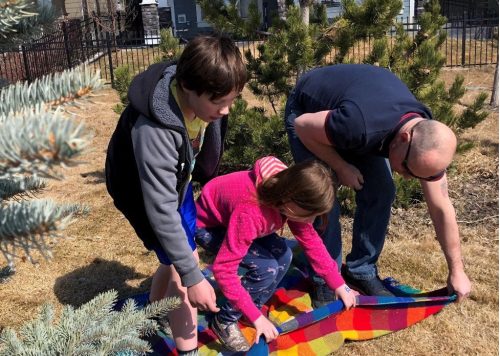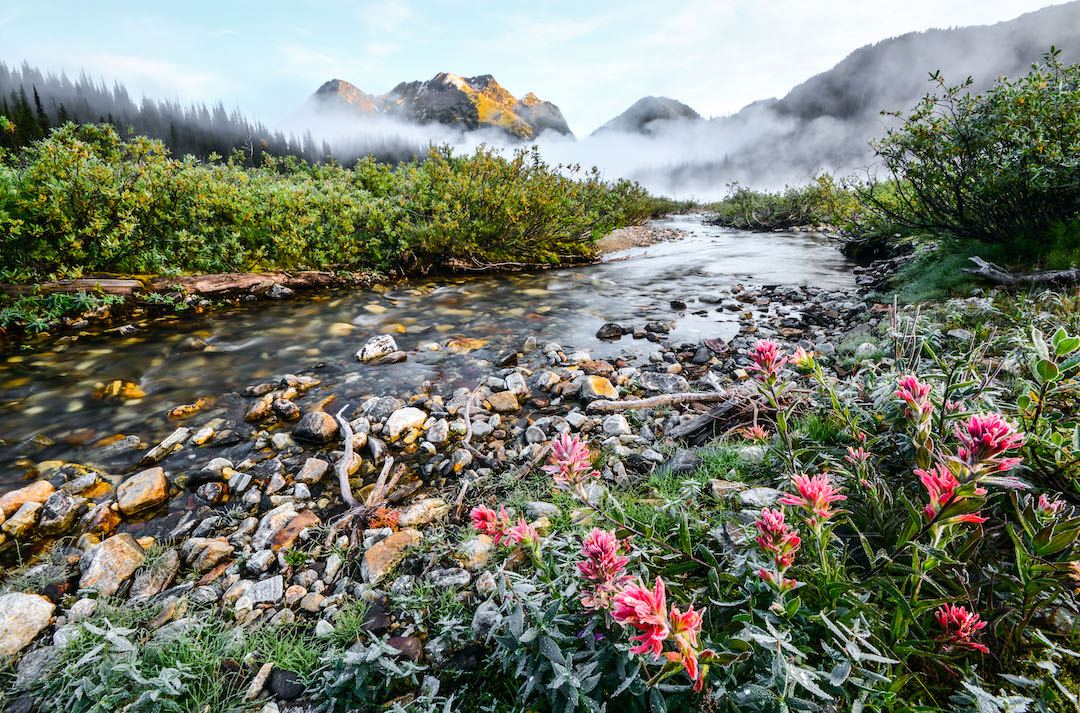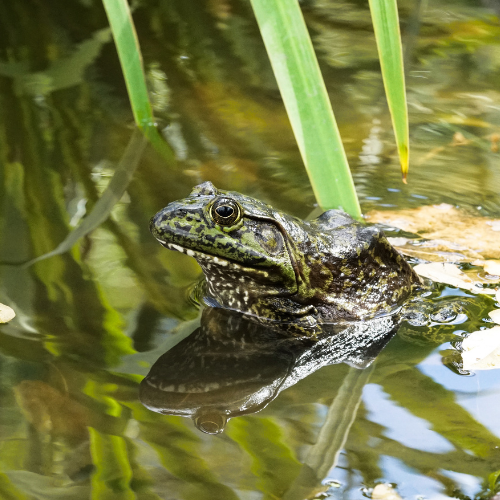Experience how young animals disperse and spread their family genes into another area
PURPOSE
In this activity, students learn about how dispersal helps young animals find a home and spread the family genes into another area. In the role of their favourite animal, students try to help their offspring disperse into new habitat areas – or deal with the horrible consequences! Students practice their basketball skills as they learn what kinds of parks are easily colonized and how this affects communities and populations. An examination of island biogeography and how grizzly bear habitat has been fragmented over time follows.
GRADE LEVELS
7-12
TIME NEEDED
30 minutes

Curriculum LINKS
Grade 7 Interactions and Ecosystems STS1,4
Grade 9 Biological Diversity STS 4
Biology 20–B1.1k, 4k, 20–B1.1sts, 20–B2.5k and 30–D1.2k, 30–D1.1sts
MATERIALS NEEDED
Download: Worksheet
An open space
12 scrap pieces of paper
6 containers of similar sizes (e.g. gallon ice cream containers)
6 containers of dramatically different sizes (e.g. large box, garbage can, large mug, etc.)
Have students collect as many of these materials as possible. Even just a few containers will work.
Instructions
Keywords: Species, species distribution, endangered species, environmental management, species diversity, populations, natural selection, limiting factors, gene pool, immigration, emigration, dispersal, colonization, island biogeography
1. Before you get started, be sure to download the related worksheet here. Ask students if they plan to always live at home. They will probably say “No!” Tell them that the same is true for ALL young animals, and that today they will learn more about how this works.
2. Ask students to define the following terms.
-
Immigration – the movement of animals into an area
-
Emigration – the movement of animals out of an area
-
Dispersal – a process in which animals move from place to place within their habitat. It is commonly used to mean the movement of adolescents away from their family group to an area where they begin life as an adult.
-
Colonize – a process in which animals disperse into an area previously uninhabited by their immediate family.
-
Island Biogeography – the study of the distribution and dynamics of species in island environments
The Area Effect
3. Students spread out their containers (of various sizes) in the pattern shown below. All containers must be the same distance from where the students stands (“national park area”) – at least three to four meters away.
4. Ask the students to wad up their scrap paper to create 12 projectiles that they think they could throw with a fair degree of accuracy.
5. Tell the students: In this game, all of you will take on the role of a wild animal that might live in a national park. What kind of animal would you like to be? Have students decide which animal they want to be (it does not change their performance in the activity, but it does turn out to be important during the discussion at the end).
In this activity, you are all parent animals. You have a large, healthy family, and all your offspring are old enough to leave home. These juvenile animals will be represented by paper balls you have made.
But this national park is overflowing with these juveniles! Due to limiting factors, they must leave. The only place that the juveniles can find good habitat and reproduce is in one of the adjacent parks (containers), which all offer suitable habitat for your animal, even though they
are different sizes. Each of the parks is surrounded by settled human farmlands, towns and cities, and your animal cannot live there. But you can travel across these areas if you are lucky.
There are two important reasons it would be good if your juvenile paper ball could ‘colonize’ these parks. One is that a large forest fire had eradicated all species from two adjacent parks. The other reason is that ALL of the other parks are isolated, and even the wildlife populations in the larger parks are beginning to suffer from inbreeding. New genetic stock from the national park is desperately needed to help those populations survive in the long term.
So… when I say “Disperse!” you will help all of your offspring disperse into the nearby parks. To represent the long and dangerous voyage through settled land, you will throw your juveniles. You can choose any park as a target.
6. Say “Disperse!” and let the students start throwing. When they are done, students count the number of balls inside each container.
7. Ask the students:
What happened to those juveniles that fell onto the floor? Without the food, water, and shelter afforded by the habitat found in parks, juveniles will eventually die. Traveling through inhospitable land is a hazardous activity; this is the reason the juveniles of most species have high death rates in their first year.
How many of your offspring made it into a park? The most successful parent “throwers” are the most likely to have their family genes occur in subsequent generations.
8. Have students summarize the data in a table, and plot the results on a graph of balls per container size. You may wish to have students do this more exactly, calculating the area of each island. Students can submit their individual data and then graph the results from the entire class.
Tell students that they have just discovered the Area Effect: parks of larger area are more likely to be colonized by juveniles than smaller parks. For this reason, smaller islands have fewer species than large islands.
The Distance Effect
9. Next have the students spread the six identical containers out in the pattern shown below. All containers must be the same size – the only difference is their distance from the national park. If you’d like the students to graph the complied class data, have them measure and use a standard distance. Again, invite the students to disperse into as many of the ‘islands’ of habitat as possible.
10. Students count the number of balls inside each container. Compile and graph the number of balls by distance from the national park.
11. Tell students that they have discovered the Distance Effect: the further an island of habitat is from the national park, the less likely it is to be colonized.
12. Ask students if their species would benefit if they placed a thin strip of land between the national park area and the closest small park. Most of them would benefit! This illustrates the usefulness of wildlife corridors, strips of land that dispersing species can use to get from one refugia to another.
13. Review with the students the basic principles of Island Biogeography, including a discussion of the genetic implications of isolation.
Some general principles of colonizing islands (land surrounded by water or disconnected, fragmented habitat)
- The closer the island to another landmass, the higher the probability of colonization.
- The older the island, the more likely it will be colonized.
- The larger the island, the more species are likely to be established.
- Geographic isolation reduces gene flow between populations.
- Over time, colonial populations become genetically divergent from their parent population due to natural selection, mutation, and/or genetic drift.
Instructions
Ask the students:
In many ways, this activity is not realistic. Why?
Students should realize that some animals that are more sensitive to human presence would not be able to disperse through the settled landscape of farmland and human habitation – particularly if there were a lot of towns and cities in that landscape. Also, when it comes to dispersal, ‘not all animals are created equal.’ The students that chose to be fast-flying birds would be able to disperse much easier than slow-moving ground mammals such as bears.
How can land managers and conservationists use this type of information when considering new parks?
- Focusing on conserving large reserves over smaller ones
- Minimize the distance between parks
- Ensure the presence of effective wildlife corridors to facilitate travel between refuges
How could human use of the landscape make it easier for animals to disperse?
Suggestions might include:
- Preserve or create wildlife travel corridors between all parks
- Build overpasses or underpasses to help animals cross train tracks and roads
- In farming areas, leave hedgerows and hedges to provide animals some cover as they travel
- Have slower speed limits and warning signs in areas used extensively by dispersing animals
More Bring Nature Home for Teachers
Bring Nature Home is our online database of tried-and-tested CPAWS Southern Alberta activities! Here are some ways that you can bring nature home (or to the classroom) today!

Habitat Stretch and Shrink

Observational Mapping




